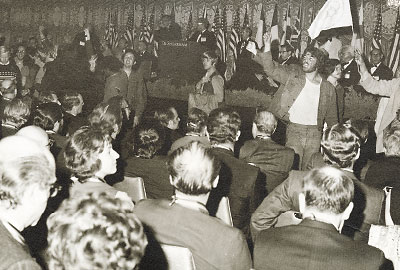Story of Homosexuality’s Removal From DSM Echoes Issues Today
Abstract
During a panel discussion about the documentary “CURED,” panelists emphasized the importance of owning APA’s and psychiatry’s past and using that knowledge to continue moving the field forward.

During the 124th APA Annual Meeting in Washington, D.C., demonstrators from the Radical Caucus and the Gay Liberation Movement disrupted the Convocation, demanding equal representation on panels to discuss homosexuality.
During a panel discussion about the documentary “CURED,” panelists emphasized the importance of telling stories about psychiatry’s past and using the lessons learned to inform discussions that are still going on today.
Jack Turban, M.D., a child and adolescent psychiatry fellow at Stanford University School of Medicine, is among the generation of psychiatrists who entered the field after the diagnosis of homosexuality was removed from DSM. For him, watching the documentary “CURED” and learning the details about the fight to remove homosexuality was incredibly impactful—and it paralleled issues that are still relevant within psychiatry today.
“I feel this film needs to be mandatory viewing for all psychiatrists,” he said during the panel discussion, which was hosted by the APA Foundation (APAF). The panel was moderated by Jacki Lyden, a journalist and the recipient of APA’s 2021 Patient Advocacy Award.
“CURED” tells the story of the push by activists outside APA and some psychiatrists within the organization to remove homosexuality from DSM, which it did in 1973. APAF provided outreach and engagement sponsorship for the documentary, which is slated for national broadcast on PBS in October.
“This is a story of heroism and leadership,” said Saul Levin, M.D., M.P.A., CEO and medical director of APA and chair of the APAF Board of Directors, during the panel discussion. “This story reminds us that we should never be silent. We should always speak up when we see discrimination.”
Turban pointed out that there are some parallels between the story “CURED” and the debate over whether the diagnosis of gender dysphoria should remain in DSM or be dropped. “We removed homosexuality in the same edition that we introduced the first diagnosis for transgender people, and over time that diagnosis has evolved,” he said.
The gender dysphoria diagnosis is controversial, he explained, because it is sometimes weaponized to imply that transgender people should undergo conversion efforts, in the same way that the diagnosis of homosexuality was weaponized. (Turban noted that he avoids using the term “conversion therapy” as it is not actual therapy.) What complicates the discussion to remove the diagnosis from DSM is that it is currently required to obtain insurance coverage for the gender-affirming medical interventions that transgender people need. Turban emphasized the importance of including the transgender community in this debate, which is a lesson that “CURED” highlighted.
Similar films should be made that chronicle other social movements within psychiatry, Levin said. Like every other medical profession, psychiatry is still learning. With regard to the anti-racism movement, he noted that Black psychiatrists have shared their experiences of not always feeling welcome in the field. “These are really tough stories to hear, but we’ve got to bring them out of the shadows, into the light, and say, ‘Let’s own our history, and let’s get better.’ ”
Patrick Sammon, the film’s co-director, said during the panel discussion that APAF’s Melvin S. Sabshin, M.D. Library and Archives was an especially rich resource while pulling the documentary together (Psychiatric News). Deena Gorland, M.S.L.I.S., APAF’s librarian and archivist, was essential in helping the directors find the documents they needed. “This story needed to be told,” Gorland said during the panel discussion. “Ultimately, I think these types of films will encourage younger generations to speak up and make change.”
Sammon recalled how he and his co-director, Bennett Singer, discovered the recording of the speech that John Fryer, M.D., gave during APA’s 1972 Annual Meeting in Dallas. Fryer was masked and identified as Dr. H. Anonymous so he could speak freely about being a gay psychiatrist. The filmmakers found the recording buried in one of the boxes that Fryer’s estate had given to the Historical Society of Pennsylvania, Sammon said. The filmmakers spent a week digging through the boxes and listening to the tapes they found—some contained recordings of bird song or organ music, but one, miraculously, had a recording of Fryer presenting his speech.
“We could have had a Hollywood actor voice the speech, but the way it comes to life by hearing his voice and hearing him try to connect with his fellow psychiatrists about the harm this classification was causing people like him really brings the story to life,” Sammon said. ■
To make a donation to the APA Foundation’s Melvin S. Sabshin, M.D. Library and Archives, text CURED to 44321. More information is posted here.



